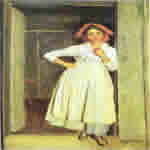These 19th Century Russian portraits certainly serve as a tribute to Russian peasants. Each painting captures individuals working–sewing, feeding animals, working in the fields–focusing on the individual, rather than the work. This trend fits in with the larger one of romantic realism: these painters do paint the individuals of the Russian working class (realism), but they do so in a very romantic light, that doesn’t truly capture the harshness of their grueling work day (romantic). Alexander Ivanov’s work clearly depicts that phenomena. In his 1830s painting of “A Girl from Albano Standing in a Doorway”, he paints a classic country woman.

He really romanticizes the country life. She isn’t working and she is wearing an overly pristine white dress. The clean white conveys purity and a certain degree of luxury; after a day (or week’s) work her dress should be ragged and filthy, but it remains simply well worn and clean. The state of her dress, paired with the pop of pink color on her head contrasts deeply with her dirty, broken in shoes and the beaten up door, and the deeply sad and pensive look on her face. All of these contradictions and surprising pairing encourage the trend of romantic realism that focuses on an idealized version of country life.
Alexei Venetsianov is known for his emphasis on peasant life and natural landscapes. His work contributes to this trend.

This scene is set in a barn, with working individuals. This is fitting for the time and the working styles of the era. This painting does also frame the working life as one of beauty and purity and simplicity. The backlight is overly rosy and its characters remarkably well dressed; the red and green hats stand out to me. The emphasis on landscape is characteristic of Venetsianov work, and the barn’s beautiful glow is really the focus of this almost fantastical piece.
